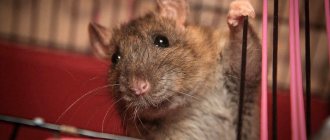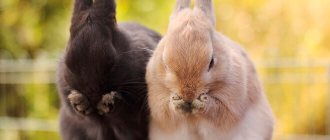What does a wild hamster look like?
It has some similarities with the domestic hamster, but differs from it in size. An adult male reaches a length of 37–39 cm and weighs up to 700 grams. The female is slightly smaller, but also quite impressive.
The field hamster has a rounded body, practically devoid of a neck, so the transition from head to body is imperceptible. The tail is 3–8 cm long, thick near the base and tapering to the tip.
Photo of a field hamster
The muzzle is of medium length with a stiff mustache and black shiny eyes. The ears are small, round, covered with dark hairs.
The teeth of a wild hamster are very long and sharp. During life they are constantly worn down and renewed.
The legs are short and strong, sometimes it seems that the hamster is crawling on the ground. The common hamster has well-developed feet and toes with long and hard claws, which are adapted for digging holes and holes.
The body of the karbysh is covered with dense soft wool with undercoat. The color of the animal is varied. There are specimens that are reddish-brown or yellow in color with a dark undercoat. There is a black and white pattern on the surface of the body.
Usually the abdomen is black in color. There are light spots on the sides, which are separated by black lines. Light spots may be present on the sides of the head, in the area of the shoulder blades and behind the ears.
Photo of a wild hamster
Very rarely in the wild there are individuals with black coloring, in which white spots are located only on the throat and paws.
The lifespan of a rodent in the wild is 4 years.
Data on wild representatives
There are 19 known species of the hamster family, belonging to mammals and rodents. There are 12 species in the country, classified into 6 genera, including:
- real;
- average;
- gray;
- hairy legs;
- rat-like;
- Eversmannov.
They have distinctive features in their appearance that allow them to be classified. By the way, the largest representative of the family in the world reaches a length of 34 centimeters, which indicates its truly impressive size.
Description of appearance
On the territory of the country there are hamsters that differ in certain external characteristics:
- from the true genus - weighing up to 500 g, yellowish-brown color, with black and white markings on the sides, distinguished by small ears, paws that look like human hands;
- from the genus of hairy-footed animals - weighing up to 30 g, sandy color with golden tint veins, there are whitish spots on the fur in the eye and abdominal area, large ears, located vertically, on the muzzle there is a kind of angular “mask” of a whitish tint;
- from the genus rat-like - weighing up to 240 g, the color is grayish-brown, turning into white in the abdomen, the tail looks like a rat's, is covered with fluff and has a whitish tint at the tip.
Almost all representatives of the hamster family living in the wild, belonging to the male sex, are significantly smaller in size than females. Hamsters are naturally endowed with four sharp teeth that do not have roots and are constantly growing. Animals have to constantly grind them down on stones.
Habitats
When trying to understand where cute creatures live in nature, it is worth understanding: the habitat is determined by belonging to a certain species. They are found in the Russian Federation, China, Mongolia, South Korea, Iran, and Syria. It is not necessary to go on a long journey to meet representatives of the class of mammals; it is enough to have information about the features of their external appearance to determine rodent settlements in landscapes close to human lands.
"Steppe People"
Another name for the steppe hamster family is ordinary; they differ significantly in appearance from their domesticated relatives. Males of this species are distinguished by increased aggression, directed at other males during the breeding season, animals much larger than them.
Representatives of the hamster family are predominantly nocturnal; their burrows are located at a depth of 8 meters and can reach 90 meters in length. It is important that this is a fairly clean animal: having excavated its hole, people find a kind of storage room, a “bedroom”, and even a toilet.
Typically, the territory patrolled by males is 12 hectares. They patronize a pair of female representatives of the species, intercourse with them during the breeding season. Joint burrows between females with cubs and males were not observed where individuals live in large numbers.
"Lesoviki"
Representatives of the forest species are rarely found in the forest belt. They do not need to have a large number of trees to arrange their own home. Zoological scientists noted data on their habitat in the forests of North America, deserts and prairies. On the territory of our country, this species is usually found near human habitations.
There is no specific way of life observed among forest hamsters. Males and females can live together, separately. When the dwelling is located not far from a person, they go hunting at night. They do not dig holes, but strengthen their homes on tree trunks, camouflaging the latter with a large number of dry branches.
"Field workers"
In Russia, individuals of the field species are found in swamps; in other habitats it is almost impossible to find them. Their tail is covered with scales, and their appearance allows them to be confused with house mice and voles. They can reach 20 centimeters in length, and dwellings are usually built in reed thickets or on the stems of the plant itself.
Living conditions
The wild hamster is widely distributed from southern and central Europe to northwestern China. It prefers forest-steppes, steppes and mixed-grass meadows. Currently, the rodent's habitat has expanded somewhat. This is due to massive deforestation.
The hamster is not afraid of human proximity, so it willingly explores the territories of personal plots, fields, orchards, and vegetable gardens. If there is not enough food, it can settle in a living room.
The field hamster is not afraid of harsh winters or cold climates. He takes refuge in his hole. The karbysh’s home has an interesting structure. It consists of several rooms and nests. The length of a wild hamster's burrow can reach 8 meters wide and 1.5 meters deep. It has up to 10 outputs, several of which are false.
Photo of a common hamster in nature
Animals are most active in the evening and at night. During the day they hide in a hole.
Rodents do not have a good disposition and show aggression towards everyone, even humans. Males are only friendly to females during the breeding season.
Hamsters are solitary animals and protect their territory. They can attack an intruder, regardless of its size.
What does it eat in nature?
The rodent is omnivorous. He has a good appetite. The main diet consists of plant foods, but in spring and summer it will not refuse insect larvae, small reptiles, crustaceans and mollusks.
With the onset of autumn, the animal consumes more plant foods. At this time, the hamster's harvesting season begins. The field hamster's diet is based on corn, peas, grains of wheat, buckwheat, millet, potatoes and carrots, the reserves of which he stores in pantries.
Wild hamster - carbysh
The rodent creates supplies thanks to its cheek pouches, which it uses to carry food. One bag holds up to 50 g of grain, which the animal can carry over a distance of more than a kilometer, supporting the bags with its front paws.
Wild hamsters store large amounts of food in their burrow. Burrows with huge reserves were discovered, hundreds of times exceeding the rodent's own weight.
Karbysh eat food while sitting on its hind legs. He eats by holding the food with his front paws and stuffing the food into one cheek, then the other, then quickly chews it.
Nutrition and lifestyle of a hamster in nature
The hamster is a solitary animal; with the exception of some species, the vast majority of rodents live independently and come together only during the mating season. They live in burrows that have an extensive system, several exits, separate “rooms” for storing supplies and a nest. Although some species build dwellings on the surface, using the branches of bushes, natural shelters near fallen trees or stones. Animals emerge from their shelters at dusk or early in the morning, preferring to sleep the rest of the time.
The food is varied. The basis of the diet consists of products that hamsters are able to obtain in the regions where they live. Usually this:
- Plant seeds and ripened grains.
- Young shoots of bushes.
- Vegetables, fruits and plant roots.
- Adult insects, larvae and worms.
- In some cases, they may feast on the remains of predators' meals or carrion.
Hymen-toed hamsters, inhabitants of near-water areas, eat mollusks and crustaceans.
Reproduction
The breeding season for wild hamsters begins in April and lasts until the end of October.
The female reaches sexual maturity at 3 months. The gestation period is 16 days, so during the summer she manages to bear offspring 2–3 times.
Males show interest in females only during mating, after which they immediately leave her. Often one rodent creates families with several females. The male does not take any part in caring for the offspring.
The average number of cubs is 10 – 18. Babies are born blind and naked. Newborns weigh only 4–6 grams. The cubs develop very quickly. At the age of two weeks, hamsters open their eyes and become covered with fur.
Common field hamster
The feeding period is 20 days, but after 7–10 days the cubs are able to eat solid food. The mother closely monitors the offspring and, in case of danger, moves the cubs to a safe place.
In the wild, rodents are unable to protect themselves from attacks by predators. Natural enemies make it possible to control the population of these animals. Birds of prey, wolves, lynxes, and foxes pose a threat to the field hamster. They may be attacked by cats and dogs in the garden area.
Control measures
All methods are good in pest control. But don’t forget about your own safety. Fighting hamsters in the garden includes the following control methods:
- Mechanical. A hamster trap is set in the garden. Professional pest control experts also advise filling minks with water.
- Chemical. To destroy harmful animals, poison is spread or acrid smoke is used.
- Traditional methods. They include treating the area with substances with an unpleasant odor, as well as growing large quantities of plants whose aroma is unpleasant for hamsters. Making your own baits also applies here.
- Ultrasonic. To expel rodents, a repeller that emits ultrasonic waves is used.
You can remove unwanted parasites from the site using various means. Each method has its own advantages and disadvantages, so we suggest you understand them better.
Fighting using mechanical methods
Inexperienced gardeners do not know how to get rid of hamsters in the country, and try to catch them by hand. Firstly, this method of fighting is ineffective, and secondly, it is dangerous, because an angry animal can bite and provoke a dangerous disease.
It is much more effective to catch rodents in a trap, but keep in mind that you will need several devices. This method is safe if you do not take your pets to the dacha, but leave them at home. When buying a trap, you need to remember that rodents can chew through it overnight. Therefore, it is better to buy devices made of metal with a thickness of at least 2 mm. A trap for wild hamsters costs about 200 rubles; it should be placed in the garden along hamster routes.
If you do not know how to catch a hamster in the country, we advise you to study the information on live traps. They look like cages with a treat attached to a trigger. When the animal touches the descent, the front door closes sharply, leaving the animal inside. You can make such a fishing device with your own hands (for example, from a suitcase or an old cage) or purchase it in a store.
Another effective way is to destroy pest holes. Examine the soil on the site and identify all the holes. They should be destroyed. This is difficult to do, because the passages can go down 1.5-2 meters. Therefore, it is most effective to fill them with water. You will have to pour out several buckets of water each turn.
The field hamster in the photo is sitting in his hole:
Chemical control methods
To drive away rodents, summer residents often use smoke bombs. An unpleasant smell forces hamsters to leave the area, but they may soon return again. Moreover, this method is also toxic to humans, so smoke treatment should be carried out in special equipment in the absence of other people and pets.
Of course, it is better to reduce the number of pests rather than take temporary measures to repel them. Poisoned baits will help with this. Advantages of this method:
- you won’t have to catch hamsters with your own hands, you won’t have to waste time destroying holes;
- Since all hamsters are thrifty guys, they will take part of the poisonous bait to their hole. As a result, not only the animal itself will die, but also the cubs sitting in the hole;
- the method is very fast and radical;
- Buying poisoned bait is cheaper than buying several traps.
You can find several types of rodent poisons in hardware stores. They are produced in the form of granules or a mass resembling dough or paste. Often the finished bait is natural grains treated with odorless poison. To attract field hamsters, sunflower oil is added to the “treat”.
The following brands of ready-made baits have proven themselves especially well:
- Varat (granules).
- Rat death (dough-like substance).
- Final MB (paste).
- Klerat (granules).
These products should be placed on cardboard pallets and placed throughout the garden, paying special attention to hamster paths. The bait should be laid out in dry weather to prevent rain from washing the poison into the soil. Do not forget that the poison is also dangerous for humans! Use gloves and wash your hands thoroughly after applying pesticides.
Attention! Fighting hamsters in the garden using poisons is unacceptable if you have dogs and cats!
Traditional methods of killing hamsters
Since ancient times, the war against uninvited guests in the areas was waged with the help of domestic animals. Cats are especially successful in this matter, but some dogs are not inferior to them. However, the hunt can end in injury for the pet: a wild hamster can bite its four-legged friend and transmit an infection to it.
A good repellent method is to water the soil with infusions of mint, onion or garlic. Furry pests cannot stand these odors, they cause suffocation, so the animals try to stay away. But this is a temporary measure, because after stopping the treatments, the animals will return to your garden.
One of the effective folk remedies for killing hamsters, mice and rats is making homemade baits. We have collected the most effective recipes for you:
- Ash paths. Ordinary ash is poured along hamster trails and into holes. When washing, it enters the digestive system. Since ash is an alkali, it quickly corrodes the intestinal mucosa. The animal dies in agony.
- Wine corks. Found in almost every home. They need to be crushed and generously sprinkled with fragrant sunflower oil, which will quickly lure the animal. In the stomach, such a treat will swell 2-3 times, forming a congestion that will not be able to pass into the intestines. As a result, the animal will die after 3-5 days.
- Alabaster cork. Combine crushed alabaster and any flour in equal proportions. Mix and place the dry mixture on a tray, and place a bowl of water next to it. A treat soaked in water acquires a cement-like structure and soon “seizes” in the stomach. The effect is the same as in the previous case.
Please note that homemade baits are just as dangerous for your pets as store-bought poisonous treats. Therefore, you should not use this method if dogs and cats roam freely in the garden.
Difference between wild and domestic hamster
Wild hamsters differ from tame pets not only in size and appearance. Rodents are quite aggressive and pose a danger to humans, and once settled in a garden or vegetable garden, they can threaten future harvests.
Unlike wild hamsters, domestic animals have a calmer and more docile character and are easily tamed.
Wild hamster eats blackberries
The common field hamster cannot be tamed, so it is much easier and safer to purchase a pet hamster.
It is not advisable to purchase several rodents, since rodents of different sexes will constantly produce offspring, and rodents of the same sex will fight.
Why did wild hamsters appear in the country? How to get rid of it?
With the onset of summer, wild hamsters often take up residence in gardens and vegetable gardens. This is due to the ripening of the crop and the beginning of the harvesting season for animals.
Rodents cause enormous harm to homestead farms. The large number of wild hamsters and the ability to adapt to any conditions allows them to quickly develop territory, and the ability to build complex burrows makes them difficult to destroy.
The presence of a hamster in the garden can be guessed by the following signs:
- tunnels and exits from holes. In the hamster they are wider than in moles and shrews;
- damaged bark in the lower part of fruit trees, since animals like to gnaw the bark at the very bottom, near the roots;
- digging in carrot beds and near potato bushes;
- the presence of characteristic small marks.
Common hamster
Currently, farmers and summer residents use different ways to deal with uninvited guests.
- Flooding holes. To do this, close all exits from the hole and pour water until the hamster crawls out. If not all emergency passages are closed, the animal can get out and run away.
- Digging holes and catching by hand. Very labor-intensive and dangerous.
- Use of traps and snares. The devices are effective, but it is very difficult to track where to install them
- Poisoned baits. Rat and mouse poisons are most often used. The disadvantage of use is the destruction of a small number of pests. Domestic cats and dogs may also be affected.
- Use of noise and ultrasonic repellers. Quite a costly method. Also, protecting a large area will require a significant number of devices.
Signs of hamsters appearing in a summer cottage
Wild species of rodents are not afraid of humans. Fighting hamsters in the garden is a troublesome task. If there is a lot of food in your area, then the animal will live peacefully and often not in one copy.
At a time when his reserves are in danger, he can put up violent resistance and attack a person, protecting his bins.
Signs of a rodent appearing in a suburban area are:
- Presence of holes and tracks.
- Numerous passages and paths along which animals move.
- Digging for tubers.
- Damaged fruits or their remains after being eaten.
- The bark at the bottom of trees or bushes has been eaten.
Having discovered trails, burrows or other signs of rodent habitation, you should immediately look for effective ways to get rid of hamsters in the garden.
A single effective method of exterminating wild hamsters has not yet been invented. Everyone chooses for themselves the most acceptable method from many existing ones.
What to do if bitten by a wild hamster?
The bite of a field hamster is very dangerous for both humans and domestic animals. The animal's teeth are very sharp and long, and when they bite, they leave deep wounds with ragged edges. In addition, fleas living on the body of a rodent are carriers of infectious diseases.
If a rodent does bite, you should immediately wash the wound with warm running water and soap and treat it with a disinfectant. To do this, you can use alcohol, hydrogen peroxide, iodine, brilliant green.
Swelling and redness may appear at the site of the bite. In severe cases, the temperature rises, general weakness and difficulty breathing occur. To prevent unpleasant consequences, you should seek emergency medical help, which includes a course of injections for tetanus and rabies.










